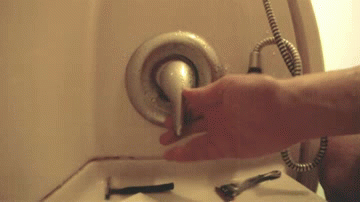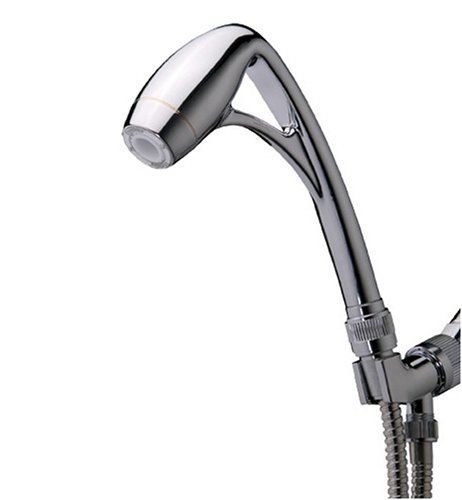RV camping is all about water management. When you need fresh water, you better have it. Life without fresh water quickly becomes intolerable.
If you are camping at a campground with water hookups, then your needs are mostly met. You don’t need to worry too much about managing your usage. But if you are boondocking or “dry camping” – camping without any water hookup, which we do often – you are reliant on a limited fixed supply. It’s critical that you use water wisely.

What other (clean) website takes you into the shower? Yep, our Navy showers last about this long in real life. But they are surprisingly satisfying, partially thanks to the Oxygenics showerhead.
No matter what kind of RV you own, you probably will have a fresh water tank. That tank contains a limited supply of water that you will use for drinking, cooking, washing, showering, and flushing. The freshwater tank in our Airstream holds 54 gallons of water. Until you go RV camping, you have no idea how much water you really use on a daily basis. In the United States, the average water usage per person (amongst non-camping persons) is 80-100 gallons per day. Think about that for a moment.
Let me repeat: we have a 54 gallon fresh water tank in our Airstream. The average daily usage for two people is 160-200 gallons. If we used water in the same way non-camping people do, our freshwater tank would be dry by noon every day! We’d constantly be running out of water, and life would be a pain in the buttocks area. But we don’t, and it isn’t. Here’s why.
Over the years, we’ve learned many techniques that help us conserve our water. Today we’ll take a look at showering in the RV when dry camping, and a product we’ve found very helpful to our cause: the Oxygenics BodySpa Handheld Showerhead.
When we are dry camping, we take “Navy showers.” The term originates with the military. Believe it or not, you can take a satisfying shower in just a couple of minutes, barely using any water at all.
There are three steps to a Navy shower. (I’m going to assume you already know about heating the water and removing your clothes.)
1. Turn on water and fully soak your hair and body, then turn off water.
2. Fully lather hair & body with shampoo and soap.
3. Turn on water to rinse hair & body completely, then turn off water.
The whole process doesn’t take very long. What’s surprising is how good you’ll feel after the Navy shower. It does the job while consuming a minimal amount of water.

It looks like a Star Wars droid, but the Oxygenics showerhead is ideal for an RV for two reasons: it boosts water pressure and uses less water.
The Oxygenics showerhead helps in two ways.
First, it delivers excellent water pressure. The design of the showerhead infuses air into the water, increasing overall pressure. No one likes a wimpy shower, yet many campgrounds offer poor water pressure. This showerhead helps eliminates the problem of low water pressure.
Second, the Oxygenics showerhead actually uses less water than a normal showerhead. The company claims that this showerhead uses “20-70% less water” than competing brands. This is a crucial advantage for RV camping.
By being miserly with our water, we are able to dry camp for days at a time. We’ve gone as long as six days without water replenishment. That means we’re using less than 10% of the water that the average American uses daily.
—–
Let’s conclude with a story. Why not?
When I was in college, I studied the Russian language. My teacher was Mrs. Gelman, a stern Russian immigrant of the World War 2 generation. Mrs. Gelman saw many travel “adventures” in her life, relocating her family from St. Petersberg, Russia to Israel (just in time for the Yom Kippur War) and finally to the United States. I sometimes referred to her as “the Russian bear” because she ruled her classroom with an iron hand and had little tolerance for foolishness.
Sometimes Mrs. Gelman would quiz her students about matters that had nothing to do with Russian. These little life lessons made our grueling study of the language more bearable.
“What is the most useful thing in any home?” Mrs. Gelman once asked the class. “What is the one, most essential necessity for life?”
Naturally, I liked to push Mrs. Gelman’s buttons. My hand shot up.
“Yes, Sasha?” she said. (All students had Russian nicknames, and mine was Sasha.)
“The microwave oven,” I beamed, straight-faced. “I couldn’t survive without mine.”
Mrs Gelman flinched and shot me an appalled look that said: Oy! The future is indeed lost.
“No, Sasha! Not microwave,” she sternly replied. “It is water. You must have water.”
Indeed. After all of these years, I’m here to report that Mrs. Gelman was right.
